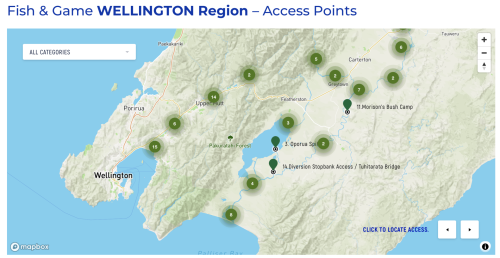Wellington Weekly Fishing Report - 23 February 2023
- Wellington
- 23/02/2023
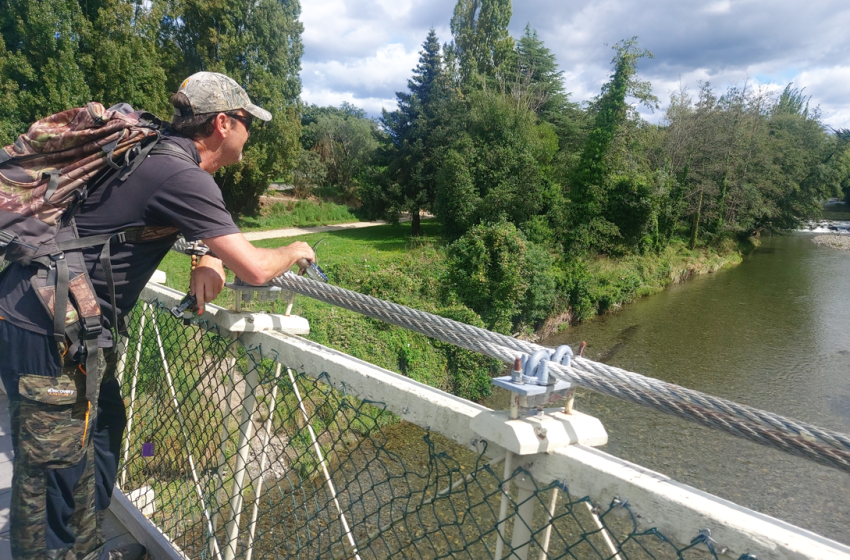
Pack the Spinning Gear, Pick Your Spot
Pictured - Spotting trout on a Ruamahanga River tributary earlier this week (Photo: Hamish Carnachan)
Most of the rivers are up again at time of writing but some of the smaller tribs look to be clear or clearing.
There's likely to be a bit of colour in the water this weekend, no matter where you choose to fish, so spin fishing is going to be the best bet.
If you're determined to flick a fly, look to those smaller waterways - many trout will have moved in to these to escape the sediment load in the mainstem rivers.
Should there still be a noticeable colour taint, consider upsizing your flies so they're more visible, or go for large streamers.
Tight lines.
Here's the outlook for the weekend:
Hutt River and tributaries
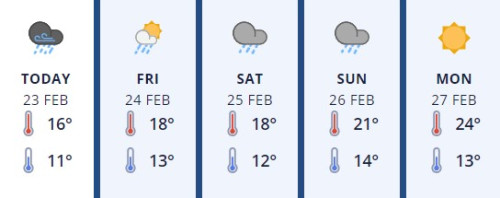
Click here for live weather updates.
Click the highlighted links for live river flow information for the Hutt and Akatarawa rivers.

The Hutt River at Stokes Valley this morning (Credit: John Miller)
Kapiti Coast
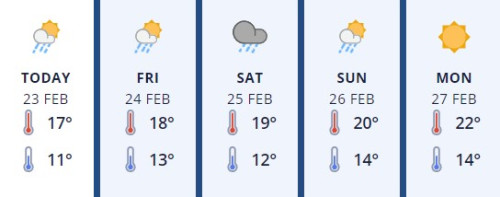
Click here for live weather updates.
Click the highlighted links for live river flow information for the Waikanae, the Otaki and the Ohau rivers.
Wairarapa

Click here for live weather updates.
Click the highlighted links for live river flow information for the Ruamahanga, the Waipoua, the Waiohine and Kopuaranga rivers.
The Waiohine River above SH2 this morning (Credit: Hamish Carnachan)
Manawatu

Click here for live weather updates.
Click the highlighted links for live river flow information for the Manawatu, the Pohangina, the Oroua and the Mangatainoka rivers.

The Manawatu River at Teachers College this morning (Credit: Horizons)
Rangitikei

Click here for live weather updates.
Click the highlighted links for live river flow information for the Rangitikei and Hautapu rivers.

The Rangitikei River at Mangaweka this morning (Credit: Horizons)
Tip of the Week - Spin Your Way to Success
 Summer Ellison with a lovely brown caught using traditional spinning technique (Credit: Ben Ellison)
Summer Ellison with a lovely brown caught using traditional spinning technique (Credit: Ben Ellison)
Whether you’re a novice looking to catch more fish, or an old-hand fly angler who wants a skill-set to overcome some of the problems river angling invariably presents, upskilling your thread-lining repertoire is the way to go.
Sure, lobbing out a Rapala or Toby when the rivers are coloured up like they are at the moment can be a sure-fire way to catch trout when a fly won’t cut it.
But being able to effectively deploy flies (and yes, even dry flies) or bait with your spinning gear will take your success to a whole new level and open up a world of opportunities even
when the water is gin-clear.
There is one area in which the fly-bubble method excels over standard fly fishing techniques and equipment and it is a game-changer – drag is reduced in the order of around 90 per cent.
As any fly angler will attest, the lines used to propel the imitation insects or fish into place are drag magnets for the very reason that they are thick.
They need this diameter for both the weight to load the rod and hence propel the flies, as well as having a large surface area to float (if nymphing or dry fly fishing).
The problem is that the thick fly line floating on the surface gets pulled around in all direction by the myriad of currents and vortexes that operate in a fast-flowing river.
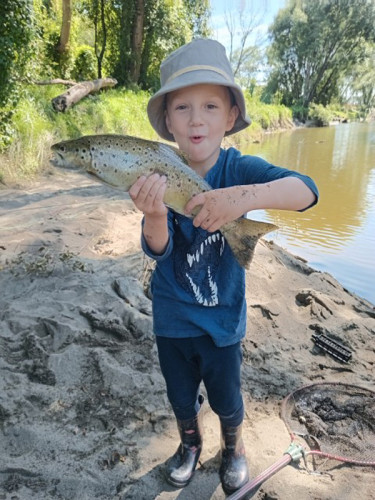 River Ellison stoked with his catch (Credit: Ben Ellison)
River Ellison stoked with his catch (Credit: Ben Ellison)
Drag can be avoided by ‘mending’ – throwing loops of line in the opposite direction to which the drag is working – but this becomes increasingly difficult with distance, i.e. the further the angler is from the flies.
Unnatural drag on the line is transmitted to the flies and if/when the wily trout sees this it’s game over; the fish will at best avoid the bad presentation, at worst it will bolt for the dark depths.
The thread-lining method uses nylon (or, better still, braid) and the weight of the bubble float to deploy the lures into position. Owing to the very thin diameter of nylon/braid, there’s barely any drag and the float freely rides along in the current.
Much like a strike indicator used by nymph fisherman, as soon as the bubble dips, stops, hesitates or shows any movement counter to the free flow of the river, you lift the rod to set the hook as a fish is likely to have taken the flies.
Because there’s no need for false casting, unlike fly angling, not only can you reach lies that would have a fly fisherman crying in frustration, you can also cast further and hence cover much more water.
This won’t appeal to the purists, but if you’re after more opportunities to catch fish and certainly a higher catch rate, then you can’t go past this method.
Simply attached the bubble float to the end of your main running line (nylon or braid) and then tie some trace that is suitably weighted for water clarity and fish size off the other side.
The length of the leader can be varied to the preferred depth. At the end of the trace tie on one or two nymphs. The first fly should be reasonably well weighted, and from the shank of this affix a more natural looking imitation.
The heavy nymph is used to get the natural deeper in the water column. Nine times out of 10 the natural will be taken.
Dry flies can be used with this technique also but requires more space to explain than we have here.
Wellington Fish & Game has several brochures on spin fishing. If you’d like to learn more and spin your way to success, contact the office via email or call 06-359-0409 and we'll get a copy sent out to you.
A Major Threat to the Future of Fishing
The Government's proposed replacement for the Resource Management Act (RMA) has major ramifications for the future of angling and access to our outdoor resource.
To find out more, and have a say, click here.
Important Survey - Please Have Your Say
Horizons Regional Council is currently collecting data on freshwater recreation in the region.
It is part of the broader Oranga Wai Freshwater Futures project Horizons is completing to set policy and regulations for freshwater management in the region.
This includes iconic fisheries like the Upper Rangitikei, Manganuiateo, Upper Whanganui which we're sure many Wellington Fish & Game anglers enjoy.
We urge you to complete the survey for each river you fish in the Horizons region.
However, it is a little cumbersome and requires some level of skill with mapping and GIS software. If you have trouble with the survey, let Horizons know and ask that they record your concern about how it has been set and that it is an inappropriate way to gather public input.
Thanks for your time taking part in this - it could have a bearing on your future enjoyment of the region's fisheries.
Angler Access - Your One Stop Shop
Click the map below and visit the one-stop shop for all your angling access information.
Noticeboard
- Treble Hooks - New regulations for the 2022-23 season ban the use of treble hooks on waterways where there are maximum size limits on trout i.e., fish over a certain size must be returned. These rivers are identified in Note 3 on page 39 of the regulations book. This measure was adopted by the Wellington Fish & Game Council to help the survival of large fish, the breeding specimens, when released after being caught. Please consult the Wellington section of the regulations guide, particularly Note 5 which details where trebles are permitted. All other waters only single hooks are allowed.
- Wellington Fish & Game has been advised of the following dates for flushing flows from the Moawhango Dam:
14 Mar, 21:00-02:00
25 Apr, 21:00-02:00
- River Bulldozing - Don't get an unwelcome surprise by Greater Wellington Regional Council's river bulldozing ruining your day on the river. The upcoming activity schedule can be found here.
If you have any information you'd like to have considered for addition to the notice board, please get in touch with us.
*This report was accurate at time of writing. For your safety please ensure you check the latest weather and river flow information before you head out on the water.
